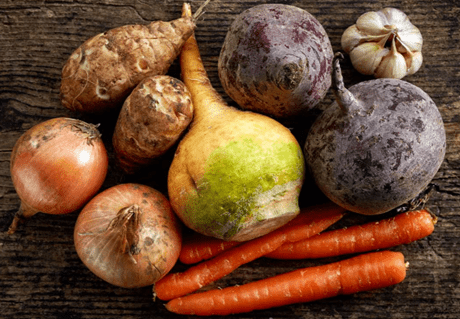Seasonal Cooking and Eating

I often hear remarks around not being sure what constitutes a seasonal food: what foods grow in what season and how do I cook seasonally?
This conundrum is understandable as produce sections have available just about any fruit or vegetable, year-round.
I invite you to try this visualization thinking about a garden you may have been familiar with growing up: close your eyes and stand beside that garden. Can you visualize what time of Summer it is and what is growing?
- what were some first foods harvested in spring,
- what foods did you wish would grow faster (strawberries and carrots, perhaps?)
- what was/is your favorite fruit or vegetable from a home garden?
Now, perhaps take a walk into that imagined garden and look at all the lush plants vying for space in the soil and really get a feel for what is growing. Often, when we think back to family gardens, our recollection of seasonal foods can re-awaken.
Living in Northern NY, our growing season is approximately May through September, although that has changed a bit in my decades of paying attention.
I loosely describe seasonal produce like this:
- vegetables that grow up and out of the ground are late spring, summer, and early fall foods: peas, asparagus, greens, tomatoes, peppers, cucumbers, summer squash…
- vegetables that grow into the ground are late fall, winter, and early spring foods: root vegetables. Try a Google search for “root veggies.” It is amazing how many root veggies there are besides carrots, beets, and potatoes.
And for the exceptions to this tidy way of looking at veggies: early root veggies are eaten in summer: young carrots, beet greens and baby beets, early parsnips, and many other root vegetables.
We have our winter keepers like cabbage and Brussels sprouts. These clearly grow above ground but mature later the in growing season and can keep well into winter.
Squash grows above ground. The winter storage varieties can be enjoyed throughout winter and into early spring, when stored correctly.
Local fruit follows a seasonal plan:
- berries in the late spring and summer: early summer strawberries followed by blueberries, raspberries, blackberries, and berries that are rarely heard about: June berries, currants, gooseberries, on & on)
- late summer apples / pears / peaches / plums, and
- fall harvest apples and pears that are winter storage fruits.

This is a quick produce explanation to inspire thinking in terms of eating locally – seasonally and remembering what produce grows and store best in what seasons.
This link will take you to a NYS Seasonal Produce Chart: https://agriculture.ny.gov/system/files/documents/2019/03/harvestchart2016english.pdf
Cooking in the Seasonal Kitchen
Cooking daily meals can be a challenge:
- keeping fresh produce in the home and using it before it gets gross
- what to cook,
- how to do it in less time,
- meals to satisfy everyone in the family
Food growing and storage for year long use is not a household habit for most anymore. Food is purchased from somewhere else for the prepping and cooking of meals. Having time to garden, shop, cook, and clean up the kitchen is not easy to fit into a 40 hour+ work week. The era of food “products” was meant to make household meal prep quick and easy. This pre-packaged food concept has flourished into millions of food products that often trade off deep nourishment for the ease of convenience. These products may be easier and less time consuming to prepare but are not always cell nourishing – whole foods.
Real food is cell medicine; the very best medicine.
Eating seasonally can make meal preparation simpler. I will admit, it takes time (as does any lifestyle change) to get used to a new way of thinking and functioning around food. Once it becomes a habit, it may become second nature.
When we eat seasonally, we have fewer choices. We are eating only what grows in season or has been stored for winter use. I garnered much information about this from my Grandmother, who grew up on a self-sustaining farm here in northern NY. From her stories of foods eaten, there was a definite seasonal rhythm to the family food stuff.
Ideas for seasonal meals:
Spring Meal Ideas: Asparagus, early salad greens, spinach, wild leeks, dandelion greens, and peas served with a nice side of protein: meat, beans, nuts & seeds, cheese, and/or eggs.
As we move into summer: more garden produce becomes available as it grows and matures and more variety in meals: baby carrots, green onions, beet greens and baby beets, radishes, turnips, rutabagas, peppers, tomatoes, summer squash….
Summer Meal Ideas: Serve up the readily available produce with whatever seasonal protein is abundant. Try your hand at raw soups such as gazpacho.
Summer foods may all blend and blur as the seasonal produce melts into the next available crop(s) to harvest.
Fall brings mature root vegetables of all types and varieties and yummy cabbages and winter squash. These pair well with heavier protein sources in soups, stews, and stir fries. Roasted meats and root vegetables can make for yummy fall and winter staple foods.
Winter meals can be served with a raw cabbage and grated root vegetable slaw. Try making these slaws ahead of time so they are marinating in the dressing. The apple cider vinegar, in the dressing, starts the breakdown of raw veggies, a supportive thing for human digestion.
Vegetarian Options for meals: beans are a hearty source of warming and filling protein. Pair the winter roasted veggies, soups, stews, and stir fries with beans, eggs, cheese, nuts and seeds, and/or roasted organic tofu.

When we eat foods, in the season they are naturally available, our health and vitality soar. Our food is fresher and freshness means higher nutrient content. From a cooking and eating perspective, each season’s transition welcomes in foods we have not had since last year. I look forward to asparagus in the spring but am equally glad to be done with it as summer marches on. I love summer’s green salads and then look forward to welcoming the cabbage and root veggie slaws. Eating seasonal food, choices come and go with the season, our cooking and meals take on a simplified seasonal rhythm.
I invite you to come back into the rhythm of seasonal foods. The Co-op carries several local farm’s produce, we can follow the seasonal flow with gratitude to the farmers growing it.
Root Veggie & Cabbage Slaw
- Assemble enough vegetable to feed the people who will be gracing your dinner table:
- red and/or green cabbage
- root veggies: beet, parsnip, rutabaga, celeriac, carrot, purple carrot, turnip, winter storage radishes, kohlrabi, salsify, burdock, horseradish, etc.
- Fine chop red and/or green cabbage
- Grate, on a metal cheese grater, your selected root veggies.
Perhaps add a chopped apple, some raisins, fresh / thawed out / dried cranberries
- Mix together in a bowl with the below dressing
- Cover and set aside until meal time.
Other options: add walnuts, sunflower seeds, pumpkin seeds, any nut or seed that makes it yummy for you.
Salad Dressing, in a wide mouth, quart canning jar
- 1 cup organic extra virgin olive oil
- 1 cup raw apple cider vinegar
- 1 tsp. organic prepared mustard of choice
- unrefined sea salt to taste
- fresh pepper to taste
- clove of garlic, pressed
- herbs to taste: rosemary, basil, oregano, thyme, parsley
- optional: 1 – 3 tbsp. maple syrup or sucanat, unrefined sugar







